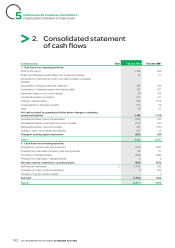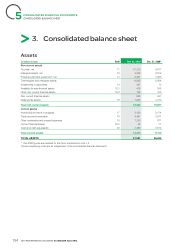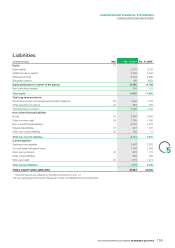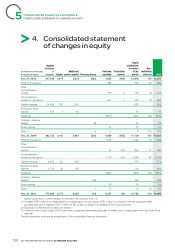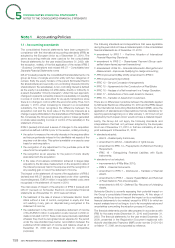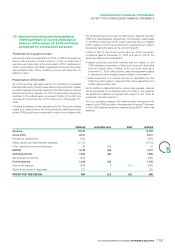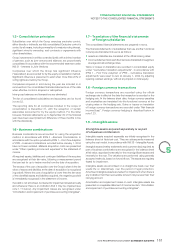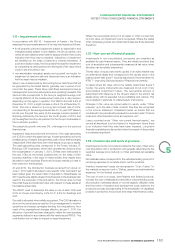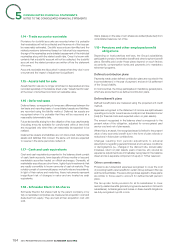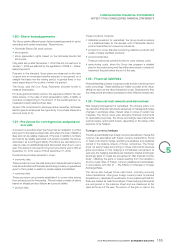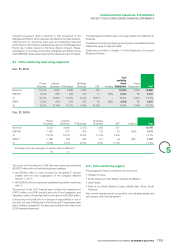APC 2010 Annual Report Download - page 163
Download and view the complete annual report
Please find page 163 of the 2010 APC annual report below. You can navigate through the pages in the report by either clicking on the pages listed below, or by using the keyword search tool below to find specific information within the annual report.
CONSOLIDATED FINANCIAL STATEMENTS
5
NOTES TO THE CONSOLIDATED FINANCIAL STATEMENTS
1.5 - Consolidation principles
Subsidiaries over which the Group exercises exclusive control,
either directly or indirectly, are fully consolidated. Exclusive control is
control by all means, including ownership of a majority voting interest,
signifi cant minority ownership, and contracts or agreements with
other shareholders.
Group investments in entities controlled jointly with a limited number
of partners, such as joint ventures and alliances, are proportionally
consolidated in accordance with the recommended treatment under
IAS31 - Interests in Joint Ventures.
Companies over which the Group has significant influence
(“associates”) are accounted for by the equity consolidation method.
Signifi cant infl uence is presumed to exist when more than 20% of
voting rights are held by the Group.
Companies acquired or sold during the year are included in or
removed from the consolidated fi nancial statements as of the date
when effective control is acquired or relinquished.
Intra-group balances and transactions are eliminated.
The list of consolidated subsidiaries and associates can be found
in note32.
The reporting date for all companies included in the scope of
consolidation is December31, with the exception of certain
associates accounted for by the equity method. For the latter
however, fi nancial statements up to September30 of the fi nancial
year have been used (maximum difference of three months in line
with the standards).
1.6 - Business combinations
Business combinations are accounted for using the acquisition
method, in accordance with IFRS3 - Business Combinations. In
accordance with the option provided by IFRS1 – First-Time Adoption
of IFRS – business combinations recorded before January1, 2004
have not been restated. Material acquisition costs are presented
under “Other operating income and expenses” in the statement of
income.
All acquired assets, liabilities and contingent liabilities of the acquiree
are recognised at their fair value, following a measurement period
that can last for up to twelve months from the date of acquisition.
The excess of the cost of acquisition over the Group’s share in the fair
value of assets and liabilities at the date of acquisition is recognised
in goodwill. Where the cost of acquisition is lower than the fair value
of the identifi ed assets and liabilities acquired, the negative goodwill
is immediately recognised in the statement of income.
Goodwill is not amortised, but tested for impairment at least annually
and whenever there is an indication that it may be impaired (see
note1.11 below). Any impairment losses are recognised under
“Amortisation and impairment of purchase accounting intangibles”.
1.7 - Translation of the financial statements
offoreign subsidiaries
The consolidated fi nancial statements are prepared ineuros.
The fi nancial statements of subsidiaries that use another functional
currency are translated into euros as follows:
•assets and liabilities are translated at the offi cial closing rates;
•income statement and cash fl ow items are translated at weighted-
average annual exchange rates.
Gains or losses on translation are recorded in consolidated equity
under “Cumulative translation adjustments”. In accordance with
IFRS1 – First Time Adoption of IFRS – cumulative translation
adjustments were reset to zero at January1, 2004 by adjusting
opening retained earnings, without any impact on total equity.
1.8 - Foreign currency transactions
Foreign currency transactions are recorded using the official
exchange rate in effect at the date the transaction is recorded or the
hedging rate. At the balance sheet date, foreign currency payables
and receivables are translated into the functional currency at the
closing rates or the hedging rate. Gains or losses on translation
of foreign currency transactions are recorded under “Net fi nancial
income/(loss)”. Foreign currency hedging is described below, in
note1.23.
1.9 - Intangible assets
Intangible assets acquired separately or as part
of a business combination
Intangible assets acquired separately are initially recognised in the
balance sheet at historical cost. They are subsequently measured
using the cost model, in accordance with IAS38 – Intangible Assets.
Intangible assets (mainly trademarks and customer lists) acquired as
part of business combinations are recognised in the balance sheet
at fair value, appraised externally for the most signifi cant assets and
internally for the rest. The valuations are performed using generally
accepted methods, based on future infl ows. The assets are regularly
tested for impairment.
Intangible assets are amortised on a straight-line basis over their
useful life or, alternatively, over the period of legal protection.
Amortised intangible assets are tested for impairment when there is
any indication that their recoverable amount may be less than their
carrying amount.
Amortisation and impairment losses on such intangible assets are
presented on a separate statement of income line item, “Amortisation
and impairment of purchase accounting intangibles”.
2010 REGISTRATION DOCUMENT SCHNEIDER ELECTRIC 161



